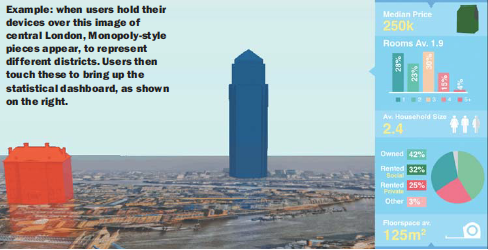You may recall back in November we introduced an exciting collaborative project called – AR in the City. Well, things are moving along nicely, and our city is becoming populated with relevant facts, data and more.
A collaborative team, consisting of AR expertise at Mimas and a number of key people across the sector has come together to create an AR Sociology experience. Come with us on a tour and understand more about different areas of the city including the social aspects of three different topics: Housing, Crime and Family. Discover some surprising facts about the city based on a London landscape, and compare and contrast data. This is aimed at sociology students, but could be used more widely for both A level students and first year undergraduates.
Who’s involved?
• Matt Ramirez – Lead AR Developer (Mimas)
• Helen Jones – Higher Education Academy (HEA) and British Society of Criminology (BSC LTN)
• Judith Mudd – Chief Executive, The British Sociological Association (BSA)
• Dr Martyn Chamberlain – Senior Lecturer in Criminology and Social Policy, Loughborough University
• John MacInnes – ESRC Strategic Advisor on Quantitative Methods Training
• James Nicholson – Consultant to the SMART Centre, Durham University
Project Expectations
The AR experience will begin with a trigger image of recognizable image of a London Landscape (see below), which will coax the user to delve deeper into different areas.
There will be three key areas: Family, Housing and Crime, which will ‘reveal’ three fictitious selectable areas of London – an affluent area, impoverish area and a commercial area. A dashboard will be displayed that will allow the user to select various related quantitative data; such as the number of people, households, ethnicity, types, and crime rates etc. Each area will allow the user to drill down further to obtain further data.
Alongside the AR experience will be a teaching support pack, which will include the key teaching & learning activities, such as videos; did you know facts; can you find questions; supporting documentation and relevant links, including the Smart Plotter.
The experience will also cover a 60-year time frame, to coincide with the BSA’s 60th birthday.
Benefits for your students
Imagine your students accessing this rich information not on a computer or laptop but on their phones or iPads, in a seminar room with you, or out in the field, engaged in self-directed learning. This is a step-change away from flat websites, but to situated learning, and increasing the student engagement. This type of learning also promotes social learning in a group environment, which you cannot achieve using websites. The simple fact that this learning activity can be achieved individually, in a group or on the move, makes this an exciting project, with further scope for development for a broad array of subjects.
So, if you are a Sociology or Criminology educator you have the chance to be amongst the first to engage with a new teaching tool which will examine social inclusion and exclusion like never before.
AR in the city will be free to use and should be available in the autumn term 2014.
Want to know more?
Colleagues within the team have produced a superb article for Network: Magazine of the British Sociological Association. Helen and Judith discuss more about what AR can do for students and teachers, with further background to the project.
We will be posting more on the final outputs in due course.



